http://timeemits.com/Articles.htm
How You Can Help
http://timeemits.com/Get_More_Time.htm
Related Article:
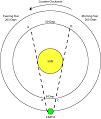 Primary 105-Year Age of Seth and Mayan
104-Year Venus Rounds
Primary 105-Year Age of Seth and Mayan
104-Year Venus Rounds
Time Emits Calendar Research Ancient Calendars of the Holy BibleAges of
Adam ToC
Articles
Videos
Holy
of Holies ToC
Get_More_Time
Christian_Era
Print Edition
from CreateSpace.com $12.99 Ebook PDF Download $ 9.95 Affiliates Blog Antediluvian Calendar Adam and Seth Enos Cainan Mahalaleel Jared Enoch 364-Days 800-Years Jewish Mayan Egyptian Donate Testimony |
|---|
How to Understand Genesis
5 Ages 2 16:20
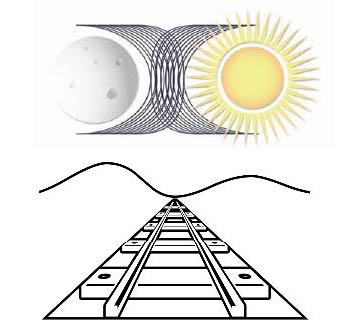 Judaism
perpetuates the 19-year lunar/solar calendar since the
Creation. Every 19-year cycle seems to reset sun
and moon positions against the stars. Consider a railroad track,
where the sun represents one rail and the moon the other. Seven
day weeks and holidays ordained namely to Moses are ties between
the tracks. God delivers rules for worship, to provide
an overarching sense of direction necessary to sustain culture.
Judaism
perpetuates the 19-year lunar/solar calendar since the
Creation. Every 19-year cycle seems to reset sun
and moon positions against the stars. Consider a railroad track,
where the sun represents one rail and the moon the other. Seven
day weeks and holidays ordained namely to Moses are ties between
the tracks. God delivers rules for worship, to provide
an overarching sense of direction necessary to sustain culture.
Background mythology was in
effect. Sun, always been there, moved across the sky daily. Moon
traveled overhead at night. Something different happened with
the moon. Moon also went across the heavens, except it changed
in terms of phases and months. When you have a calendar that
lasts only 7-days, you are going to repeat it. A month
long calendar also repeats. And a 19-year lunar/solar
calendar repeats too. Sun was consistent, but Moon had her
monthly periods. Sun and Moon had celestial relations, and
Wahlah!
Ancient Calendar
Diagram.jpg
Audio was Leader5.wav 34.2 Mb and converted to
HTU_Gn5_Ages_2b.mp3 4.65 Mb for faster download. 3:23.
Four different main calendar systems are recognizable today. The
Egyptian Calendar version referred to had lunar/solar origins
and was broadly regional. Stretching from North Africa to beyond
the Nile River, Egyptology begins dating the first Pharaoh
dynasty about 3100 BCE. Before upper and lower Egypt were united
as one land, before later Pharaohs and magnificent pyramids came
about, a chiefly agricultural calendar developed.
The third main branch of
lunar/solar calendar science to explore is the Mayan Calendar.
Most evidence for calendar numbering stems outward from Central
and South America. Again, regional geography is the best
approach, taking into account the many diverse cultures under
their vast umbrella calendar system. Parts of the Mayan
Calendar, together with associated religious mythology are
pervasive throughout the Americas. Fundamental to the Mayan
Calendar are two interlocking cycles known as the 360-day-Tun-year
and its counterpart, a 260-day-Tzolken-sacred-year.

Mayan terminology is used to describe recurring time. Mayans
were indigenous to the population, consisting of elite holy men
and political leaders. Of course there's a disconnect here.
Classical Mayan Calendars did not happen for several thousand
years after Genesis. We tightly focus upon time counting
procedure. A bit of reverse engineering helps explain the Antediluvian
Calendar plan. Mayans deserve credit for passing down
legacy information via picture carvings that survive in stone.
Scholars have since drawn upon translation for principles of
Native American cosmology.
Ethiopic is the fourth branch shown in the Antediluvian Calendar Diagram. As the least known calendar, it carries both Jewish and Egyptian calendar roots, and is most likely the oldest. Ethiopic is a special Hebrew version derived from Genesis study. Mixed attributes involve early Judaism and Egyptology, with further insight gained from alternative sacred texts. The 364-day-Ethiopic-year is a lynchpin calendar system that allows for single day-to-year numerical matching. Understanding the Ethiopic-Enochian version is imperative to our remote lunar/solar calendar study of Genesis, chapter 5.
Hyphenated phrases join certain key words and concepts. Illustrations are invaluable to visualizing word pictures from the text. Calendar material embodies profound religious eschatology throughout Ages_of_Adam and later Holy_of_Holies. You may find yourself on the very threshold of the supernatural.
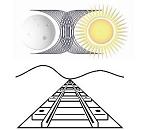 |
Understand_Genesis_5_Ages_2
The Antediluvian
Calendar gave rise to at least four different forms
of ancient calendar systems. Lunar/solar ages shown by Genesis
predicated the solar Egyptian Calendar instrument
frequently applied to remote chronology. Judaism
perpetuates the 19-year lunar/solar calendar since the
Creation. One day bridges Jewish 19-year and Mayan 20-year
l/s cycles. Cart Item Gn5A2VT includes Video 2
download .mp4, 31 mb and this transcript PDF download
616 kb
from Paypal-Payloadz for Only $ 1.98 |
V-31 mb T-616 kb 1.98 |
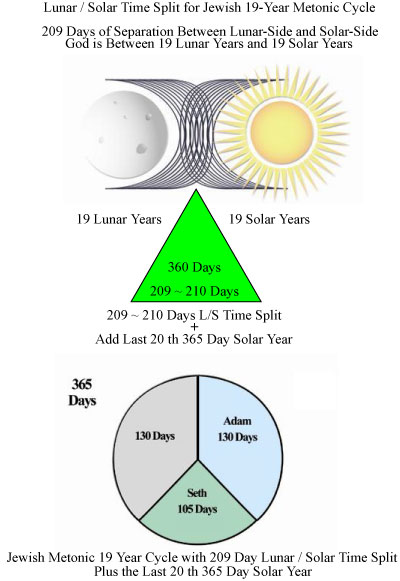 LSTS_Metonic_19-20Y.jpg
with audio voice over segment. 2:15
LSTS_Metonic_19-20Y.jpg
with audio voice over segment. 2:15The character Seth in the lower circle shows 105-days in darker green. Numerical matching takes place by equally dividing 210-days into 105-days for the lunar-side, feminine gender and 105-days for the solar-side, masculine gender. Adam introduces the first 130-day half of a Mayan 260-day-Tzolken-sacred-year. Solar-side matching occurs between the masculine 105-days and Seth's age. The Jewish Calendar 19-year Metonic cycle easily adapts to a Katun style, 20-Tun-year early lunar/solar calendar system. Fixed cultures in northeast Africa and Egypt may have used a (the same) Katun style 20-Tun-year system prior to the Exodus. Early Israelites shifted to a more mobile lunar/solar calendar following Exodus 12:2. Egyptian cosmology concentrated upon a stricter solar calendar after about 1450 BCE.
See Mayan Calendar Scripts – Excerpt from Mayan Calendar 260-d Tzolken sacred y and 360-d Tun y.avi http://youtu.be/G618gUyIzC0 5:08
Author's note:
Tzolken 260-day-sacred-years and (Tun) 360-day
midpoint length of years are integral to the 52-year
Calendar Round. Last 5-days form the Wayeb holiday
terminal for every 365-day-solar-year. Explains Mayan
20-year Katun lunar/solar cycle and the squared term, 400-year
Baktun l/s cycle. Slides 11-12a.avi
Slide 11a.jpg
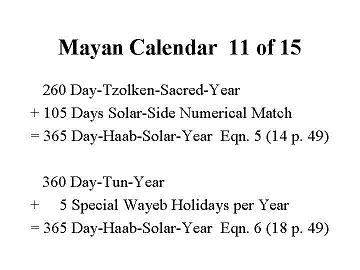
Slide_11a.avi
3:23 699 Mb from
260 Day-Tzolken-Sacred-Year and 360 Day-Tun-Year 15 seconds
duration
260 Day-Tzolken-Sacred-Year
+ 105 Days Solar-Side Numerical Match
= 365 Day-Haab-Solar-Year Eqn. 5 (14 p. 49) in Ages_of_Adam
360 Day-Tun-Year
+ 5 Special Wayeb Holidays per Year
= 365 Day-Haab-Solar-Year Eqn. 6 (18 p. 49) in Ages_of_Adam
The Mayan calendar 360-day-Tun-year (Tūn is pronounced
toon) accompanies the 260-day-Tzolken-sacred-year in dual
numbering. Mayan 360-day-Tun-years have 18 named months
of 20-days each. A 260-day-Tzolken-sacred-year has 20
periods of 13-days each. Five special days called Wayeb
attach to a 360-day-Tun-year to complete a 365-day-Haab-solar-year
(Eqn. 18 p. 49). See figure 7 on page 50. The first day following
the five-day span marks the beginning of the next of 365-day-Haab-solar-year.
Archeologists have studied ornately carved stele or standing
stones to discern the calendar. Wide agreement refers to a 365-day-Haab-solar-year
serving a civil function. Following the 360-day-Tun-year,
religion maintained the five Wayeb holidays as unlucky for
ordinary work. Sabbath and Wayeb rest days are parallel theology.
Mesoamerican calendars emphasize solar-side reckoning and
numerical matching. However, 7-day-weeks and
7-intercalary-months did not share religious favor as in
Judaism. Sister calendars treat the civil year, including the five
extra holidays similarly.
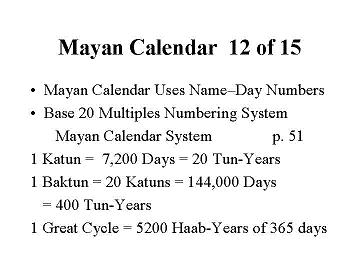 Slide
12a.jpg Mayan Calendar Katun, Baktun, Great Cycle 15 Seconds
Duration
Slide
12a.jpg Mayan Calendar Katun, Baktun, Great Cycle 15 Seconds
Duration
Mayan Calendar Uses Name–Day Numbers
Base 20 Multiples Numbering System
Mayan Calendar System p. 51
1 Katun = 20 Tun-Years = 7,200 Days
1 Baktun = 20 Katuns = 144,000 Days = 400 Tun-Years
1 Great Cycle = 5200 Haab-Years of 365 days
Slide_12a.avi 1:59 410 Mb
Mesoamerican calendars incorporate repetitive multiples of 20-days
and 20-years in a dominant recurring theme of numerical
matching. The 20-year lunar/solar calendar cycle marks the
time split that cuts 210-days in half. To create later 20-year
cycles, ancient people divide the 210-days of
lunar/solar separation time equally for two halves of 105-days
each. The feminine lunar-side time split is 105-days and the
masculine solar-side time split also is 105-days (Eqn. 4 and
10, page 33). Feminine and masculine genders describe time splits
according to layers.
The 20-year multiple of the Tun adds a prefix to
make the Katūn. The Mayan calendar goes far beyond the Katun
20-year lunar/solar cycle. Greater time measurements
multiply Katun 20-year-cycles by Katun 20-year-cycles again,
or square time to create an upper calendar tier. The result
is a Baktun 400-year lunar/solar cycle. Day number-name
combinations describe 52-year Calendar Rounds. Mayan
Calendar System name sequences range from 1-Kin-day to the 5200-year
Great Cycle on page 51.
Adam_Seth_Days_to_Years.jpg for Adam_Seth_Days_to_Years.mp4 or
http://youtu.be/dAhsUe8wGuM
630 kb 0:21 adjust
Audio was Leader6.wav 31.9 Mb and converted to
HTU_Gn5_Ages_2c.mp3 4.33 Mb for faster download. 3:10
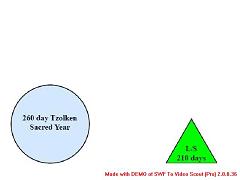 In the next
animation, look closely to see three quick loops. Seth's
primary age 105-days are used to divide a 260-day-Tzolken-sacred-year.
Seth's 105-day solar-side time split in the green triangle
equally divides 260-days. Adam's 130-day primary age
follows a complete Mayan lunar/solar Katun 20-year cycle.
Every Katun 20-year cycle returns the Sun and Moon
to their starting positions. Ancients multiplied 20-years
having 360-days by itself in order to square time. They had
no way to write 20-years of 20-years, so they simply
called them 400-years. Numerical matching of days and
years is the answer. In other words, X-number of days
also mark X-number of years. After one whole Mayan
Baktun 400-year cycle, Sun and Moon again return to their
same starting positions. The result changes 105-days of
solar-side time split into 105-years of solar-side time split
for every Baktun 400-year cycle.
In the next
animation, look closely to see three quick loops. Seth's
primary age 105-days are used to divide a 260-day-Tzolken-sacred-year.
Seth's 105-day solar-side time split in the green triangle
equally divides 260-days. Adam's 130-day primary age
follows a complete Mayan lunar/solar Katun 20-year cycle.
Every Katun 20-year cycle returns the Sun and Moon
to their starting positions. Ancients multiplied 20-years
having 360-days by itself in order to square time. They had
no way to write 20-years of 20-years, so they simply
called them 400-years. Numerical matching of days and
years is the answer. In other words, X-number of days
also mark X-number of years. After one whole Mayan
Baktun 400-year cycle, Sun and Moon again return to their
same starting positions. The result changes 105-days of
solar-side time split into 105-years of solar-side time split
for every Baktun 400-year cycle.
The second part of the animation changes all days to years. The green triangle 105-years divides 260-years in three loops. When you multiply 5 and one-quarter days by 20-years, you get 105-days. When you multiply 5 and one-quarter years by 20 more 20-year cycles, you get 105-years. The remaining 260-days, therefore likewise convert into 260-years.
Genesis 5:6 gives the Primary 105-year age of Seth. Adam's primary 130-year age is given by Genesis 5:3. The first 260-day-Tzolken-sacred-year numerically matches with the first 260-year-Tzolken-sacred-cycle. Adam is assigned the first 400-year Baktun Cycle to bisect 260-years in the second part of the animation. Three loops are again shown. At the website, Adam 400-year Baktun Cycle 1 identifies the first of 13 such 400-year Baktun Cycles.
The next video in the series details more about character primary
and secondary age numbering. Venus and other heavenly
topics are discussed in terms of astronomy and mythology.
You Can Always Get_More_Time at Timeemits.com
tags Genesis, Bible, ancient, Adam, Seth, Egypt, Jewish, Mayan, Mythology, solar, lunar, Judaism (Religion), Spirit
Clark Nelson is webmaster for http://timeemits.com/Get_More_Time.htm,
author of Ages_of_Adam
and sequel, Holy_of_Holies.
Original web content media by Clark Nelson and timeemits.com
Copyright 2014 All Rights Reserved. URL http://timeemits.com/Scripts/HTU_Gn_5_Ages_2_Script.html